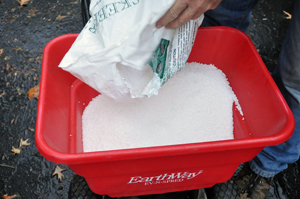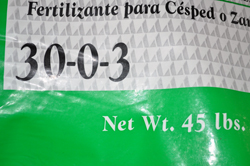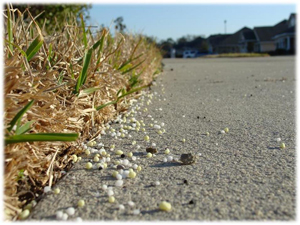Fertilize Kansas City Cool Season Lawns in September
 September is the best time of the year to fertilize cool season lawns such as tall fescue and bluegrass. If you could only fertilize your cool-season grasses once per year, this would be the best time to do it.
September is the best time of the year to fertilize cool season lawns such as tall fescue and bluegrass. If you could only fertilize your cool-season grasses once per year, this would be the best time to do it.
These grasses are entering their fall growth cycle as days shorten and temperatures moderate (especially at night). The stress of summer depletes the turf of the nutrients needed for proper growth during the more ideal temperatures and moisture levels of fall.
Cool-season grasses naturally thicken up in the fall by tillering (forming new shoots at the base of existing plants) and, for bluegrass, spreading by underground stems called rhizomes. Consequently, September is the most important time to fertilize these grasses.
Lawns need nitrogen
Nitrogen (N), the first number listed on a bag of fertilizer, helps thicken the stand and encourage development of a healthy root system. Apply 1 to 1.5 pounds of actual nitrogen per 1,000 square feet. The settings recommended on lawn fertilizer bags usually result in about 1 pound of nitrogen per 1,000 square feet.
A strong root system is the foundation of a nice lawn. Cooler temperatures, fall rains and the addition of the nutrients help the lawn to recover from stressful summer conditions. The food is converted into new roots, crowns and shoots. This application helps to thicken up thin areas. A dense healthy lawn is our best defense against weeds and that prevention starts with this application of fertilizer.
What to look for when purchasing lawn fertilizer
 Based on the needs of the grass and the local soil conditions, fertilizers containing higher concentrations of nitrogen should be used at this time. Bags of fertilizer will always have three numbers displayed. The numbers stand for the percentage of nitrogen, phosphorus and potassium contained in the bag. Examples of fertilizers to apply in the fall have numbers such as 30-0-0 or 29-5-4 or 27-3-3.
Based on the needs of the grass and the local soil conditions, fertilizers containing higher concentrations of nitrogen should be used at this time. Bags of fertilizer will always have three numbers displayed. The numbers stand for the percentage of nitrogen, phosphorus and potassium contained in the bag. Examples of fertilizers to apply in the fall have numbers such as 30-0-0 or 29-5-4 or 27-3-3.
Choosing the right type of fertilizer is important. Nitrogen in fertilizer is the most important nutrient, as it is needed in the greatest quantities by the turf. We recommend a quick-release source of nitrogen at this time. Most fertilizers sold in garden centers and department stores contain either quick-release nitrogen or a mixture of quick- and slow-release. Usually only lawn fertilizers recommended for summer use contain slow-release nitrogen. Any of the others should be quick-release. Remember, nitrogen is essential for healthy growth, color and density. Vigorously growing lawns use more than is available in the soil, so it must be replenished on a regular basis.
The other two numbers, P & K
Phosphorus (P), the second number listed on the bag, is needed for growth of roots and shoots. Adequate quantities are often present in the soils of established grass. Potassium (K), the third number listed, is essential for the overall health, stress resistance and cold hardiness of lawns. Like phosphorus, it normally is found naturally in the soils. Applications of fertilizers containing phosphorus and potassium are not recommended unless a soil test indicates the need.
November: The second most important application of lawn fertilizer
November is the next most important time to fertilize. The timing of this application should be around the final mowing of the season, normally mid-month. It also should be quick-release applied at the rate of 1-pound actual nitrogen per 1,000 square feet. This enables the lawn to green up earlier in the spring, without encouraging the excessive shoot growth that often accompanies early spring application.
Protect our water quality. Keep products off of hard surfaces
 The easiest way to protect our water quality is by sweeping or blowing fertilizer and granular products off all hard surfaces back onto the lawn. Fertilizers left on hard surfaces wash into storm drains during rainfall, which ends up in our ponds and streams. These chemicals pollute our waterways. Fertilizer blown back onto the lawn is absorbed and keeps your money from going down the drain.
The easiest way to protect our water quality is by sweeping or blowing fertilizer and granular products off all hard surfaces back onto the lawn. Fertilizers left on hard surfaces wash into storm drains during rainfall, which ends up in our ponds and streams. These chemicals pollute our waterways. Fertilizer blown back onto the lawn is absorbed and keeps your money from going down the drain.
Water after applying fertilizer
If rain is not in the immediate forecast you will need to water the lawn after you have applied the fertilizer.
Fertilizing lawns in the spring
This emphasis on fall fertilization may conflict with some that promote spring applications. Cool season lawns experience a flush of shoot growth in the spring. Applying fertilizer before this flush is over can cause the grass to grow too fast. The rapid growth exhausts the plant’s food stock and leaves it with few reserves for the stressful summer ahead. Therefore, it is best to wait until the flush is over, usually in early May, before making any spring applications.
For complete information on lawn fertilization, contact our Extension Master Gardener Gardening Hotline at 913-715-7050.
Other Resources
- Fertilizing Kansas Lawns
- September: Time to Core Aerate the Lawn
- September: Time to Reseed Cool Season Lawns
- Lawn Fertilizing Guide